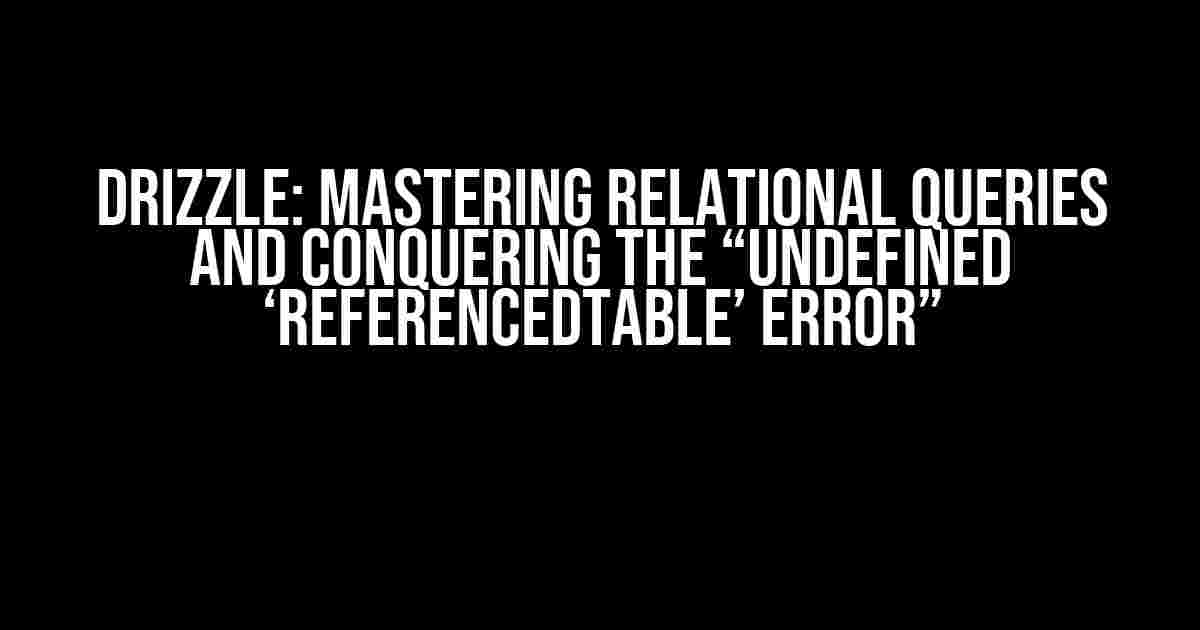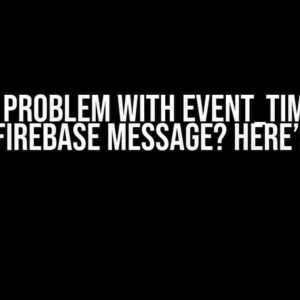The Power of Relational Queries in Drizzle
Drizzle, a modern and lightweight ORM (Object-Relational Mapping) tool, allows developers to effortlessly interact with their databases. One of its most powerful features is the ability to create complex relational queries with ease. However, this feature can sometimes throw a curveball in the form of the mysterious “undefined ‘referencedTable’ error.” Fear not, dear developer, for this article will guide you through the process of creating robust relational queries in Drizzle and provide a comprehensive solution to this pesky error.
Understanding Relational Queries in Drizzle
In Drizzle, relational queries are used to fetch data from multiple tables based on their relationships. This is achieved by defining a model and its associated relationships, which Drizzle then uses to generate the necessary SQL queries. For instance, let’s consider a simple example where we have two models: `Author` and `Book`. An author can have multiple books, and a book belongs to one author.
// models/Author.js
import { Model } from 'drizzle';
class Author extends Model {
static tableName = 'authors';
static fields = {
id: {
type: 'increments',
primaryKey: true,
},
name: {
type: 'string',
},
};
static books() {
return this.hasMany('Book', 'authorId');
}
}
// models/Book.js
import { Model } from 'drizzle';
class Book extends Model {
static tableName = 'books';
static fields = {
id: {
type: 'increments',
primaryKey: true,
},
title: {
type: 'string',
},
authorId: {
type: 'integer',
references: {
table: 'authors',
column: 'id',
},
},
};
static author() {
return this.belongsTo('Author', 'authorId');
}
}
The Anatomy of a Relational Query
A relational query in Drizzle consists of three main components:
- The Base Query: This is the primary query that fetches data from the main table.
- The Relationship: This defines the connection between the main table and the related table(s).
- The Join: This specifies how the main table should be joined with the related table(s).
Creating a Simple Relational Query
Let’s create a relational query to fetch all authors along with their associated books. We’ll use the `Author` model as the base query and define a relationship with the `Book` model.
const authorsWithBooks = await Author.query()
.with('books')
.fetch();
The “Undefined ‘referencedTable’ Error”
So, what happens when you encounter the infamous “undefined ‘referencedTable’ error”? This error typically occurs when Drizzle is unable to determine the referenced table in a relationship. This can happen due to various reasons, such as:
- Missing or incorrect relationship definition: Ensure that the relationship is properly defined in the model, including the correct table and column names.
- Typo or incorrect table/column name: Double-check that the table and column names in the relationship definition match the actual database schema.
- Missing or incorrect foreign key definition: Verify that the foreign key is correctly defined in the model, including the correct column name and referenced table.
Solving the “Undefined ‘referencedTable’ Error”
To resolve this error, follow these steps:
- Review the relationship definition: Double-check the relationship definition in the model, ensuring that the correct table and column names are used.
- Verify the database schema: Confirm that the database schema matches the model definition, including the correct table and column names.
- Check the foreign key definition: Ensure that the foreign key is correctly defined in the model, including the correct column name and referenced table.
- Use the correct join type: Verify that the correct join type (e.g., innerJoin, leftJoin, rightJoin) is used in the query.
Advanced Relational Queries
Now that we’ve explored the basics of relational queries and conquered the “undefined ‘referencedTable’ error,” let’s dive into some advanced scenarios:
Multiple Levels of Relationships
Sometimes, you may need to fetch data from multiple levels of relationships. For instance, let’s assume we have an additional model, `Genre`, which is related to `Book`. We can fetch authors along with their books and genres using the following query:
const authorsWithBooksAndGenres = await Author.query()
.with('books.genre')
.fetch();
Eager Loading with Constraints
In some cases, you may want to apply constraints to the related data. For example, let’s fetch authors along with their books that have a rating greater than 4:
const authorsWithHighlyRatedBooks = await Author.query()
.with('books', (builder) => {
builder.where('rating', '>', 4);
})
.fetch();
Pagination and Limiting
When dealing with large datasets, it’s essential to implement pagination and limiting to optimize performance. Drizzle provides an easy way to achieve this using the `perPage` and `page` methods:
const authorsWithBooks = await Author.query()
.with('books')
.paginate(10) // fetch 10 authors per page
.page(2) // fetch the second page
.fetch();
| Authors | Books |
|---|---|
| John Doe |
|
| Jane Doe |
|
Conclusion
In this article, we’ve explored the world of relational queries in Drizzle, covering the basics of creating robust queries and conquering the “undefined ‘referencedTable’ error.” By following the instructions and guidelines provided, you’ll be well-equipped to master the art of relational queries in Drizzle and unlock the full potential of your database.
Frequently Asked Questions
Get the answers to your burning questions about Drizzle creating relational queries and the pesky ‘referencedTable’ error!
What is Drizzle and how does it help in creating relational queries?
Drizzle is an open-source framework that simplifies the process of creating relational queries. It provides a more intuitive and efficient way of defining relationships between tables, making it easier to write complex queries. With Drizzle, you can define relationships using a simple, declarative syntax, and the framework takes care of generating the underlying SQL code.
What is the ‘referencedTable’ error, and why does it occur in Drizzle?
The ‘referencedTable’ error occurs when Drizzle is unable to resolve the table referenced in a relationship definition. This can happen when the referenced table is not properly defined or is not accessible. To resolve this error, make sure that the referenced table is correctly defined and that Drizzle has the necessary permissions to access it.
How do I define relationships in Drizzle to avoid the ‘referencedTable’ error?
To define relationships in Drizzle, you need to use the `belongsTo`, `hasOne`, `hasMany`, or `belongsToMany` methods, depending on the type of relationship. For example, `user.belongsTo(role, { foreignKey: ‘roleId’ })` defines a belongs-to relationship between the `user` table and the `role` table. Make sure to specify the correct foreign key and referenced table to avoid the ‘referencedTable’ error.
Can I use Drizzle with complex relational databases, and if so, how?
Yes, Drizzle is designed to work with complex relational databases. You can define multiple relationships between tables, including self-referential relationships and polymorphic relationships. To work with complex databases, break down the relationships into smaller, more manageable pieces, and define each relationship incrementally. This will help you avoid errors and ensure that your relationships are correctly defined.
What are some best practices for using Drizzle to create relational queries?
Some best practices for using Drizzle include defining relationships explicitly, using meaningful names for tables and fields, and following a consistent naming convention. Additionally, use Drizzle’s built-in validation and error handling mechanisms to catch errors early, and test your relationships thoroughly to ensure they are correctly defined.





